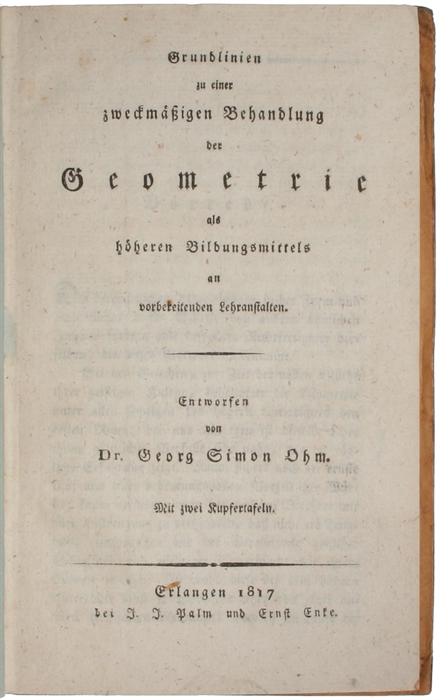OHM'S FIRST WORK
OHM, G.S. (GEORG SIMON).
Grundlinien zu einer zweckmässigen Behandlung der Geometrie als höheren Bildungsmittels an verbereitenden Lehranstalten. Mit zwei Kupfertafeln.
Erlangen, J.J. Palm und Ernst Enke, 1817. 8vo. Nice cont. marbled cardboardbinding w. gilt title label and single gilt lines to spine. Corners and edges of boards bumped and some minor wear to capitals, otherwise very nice and clean. Also internally in excellent condition, w. almost no brownspotting. A few leaves w. marginal markings, all in weak pencil. Printed on good paper. XXXII, 224, (2, -errata) pp, 2 folded plates.
The very rare first edition of Ohm's first work, which actually laid the foundation for his career and gave him the opportunity of working as a scientist. The work was printed eight years before his first scientific paper, ("Vorläufige Anzeige des Gesetzes, nach welchem Metalle de Contakt-elektrizität leiten", 1825, which contained for the first time the original research that was to immortalize his name).
The German physicist Georg Simon Ohm (1789 -1854), who later became famous for having established the fundamental relationship between voltage, current, and resistance, and thereby founding electrical circuit analysis (all based on what has ever since Ohm been known as "Ohm's Law"), was solidly educated in mathematics, physics, chemistry and philosophy by his very skilled autodidact father. From 1800 to 1805 Ohm attended the Erlangen Gymnasium, after which he attended the University of Erlangen for three years, until his father withdrew him and placed him in exile in Switzerland, because he was so dissatisfied with him wasting his scientific abilities; -Georg Ohm was primarily interested in dancing, billiards and ice skating. He then became a mathematics teacher in Gottstadt bei Nydau, and in 1809 he went to Neuchâtel for two years as a private teacher, although he would have preferred to follow Karl Christian von Langensdorf to Heidelberg to restart his mathematical studies. Langendorf, however, advised Ohm to study mathematics on his own and to read the works of Euler, Laplace and Lacroix, which he did. In 1811 Ohm returned to the University of Erlangen, where he received his PhD. He now taught as a Privatdozent for three semesters, but he could not advance and made almost no money, so he was forced to seek employment from the Bavarian government. The best position that he was offered was that of a teacher of mathematics and physics at a poor quality, low-prestige Realschule in Bamberg, where he stayed with great dissatisfaction for three years, until the school got closed down in March 1816. He was now assigned to teach a section of mathematics at another overcrowded and ill reputed school in Bamberg.
During these years, Georg Ohm felt very unhappy with his position and realized that he had to do something to improve his merits in order to get out of Bamberg and have hopes to find a better post. And thus, he undertook the writing of his first work, the elementary geometry text, which was to prove his true abilities. Ohm sent the manuscript to King Wilhelm III of Prussia, and in 1817 he was offered the position of Oberlehrer of mathematics and physics at the recently reformed Jesuit Gymnasium at Cologne. This was a very good school, which was based on the ideals of proper scientific education and enthusiasm for learning and teaching, and it was this position that stimulated Ohm to seriously concern himself with physics which he had never done before. The physics lab was very well equipped , and Ohm could now devote himself to experimenting on physics.
"Ohm's fist work was an elementary geometry text, "Grundlinien..." which embodied his ideals on the role of mathematics in education. The student, he believed, should learn mathematics as if it were the free product of his own mind, not as a finished product imposed from without. Ideally, by fostering the conviction that the highest life is that devoted to pure knowledge, education should create a self-respect capable of withstanding all vicissitudes in one's external circumstances. One detects in these sentiments the reflection not only of his own early education but also of the years of isolation in Switzerland and of personal and intellectual deprivation of Bamberg. The resulting inwardness of Ohm's character and the highly intellectualized nature of his ideals of personal worth were an essential aspect of the man who would bring the abstractness of mathematics into the hiterto physical and chemical domain of galvanic electricity." (D.S.B., X, p. 187).
Order-nr.: 36757


